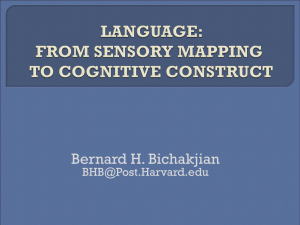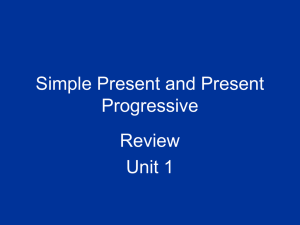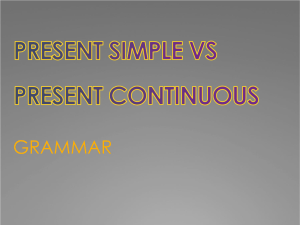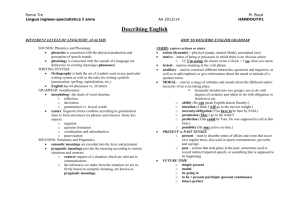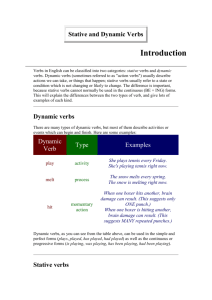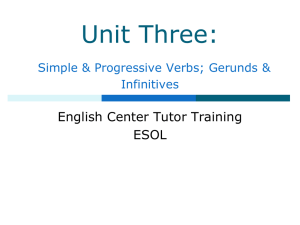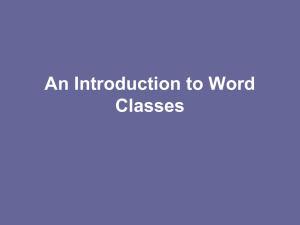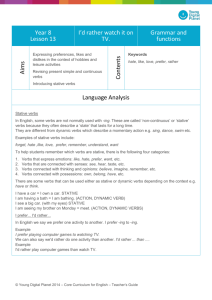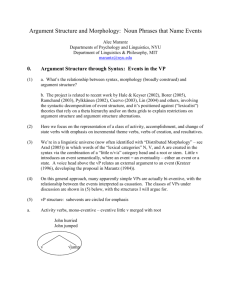Dogon stative verbs including `be (somewhere)` and `have`
advertisement
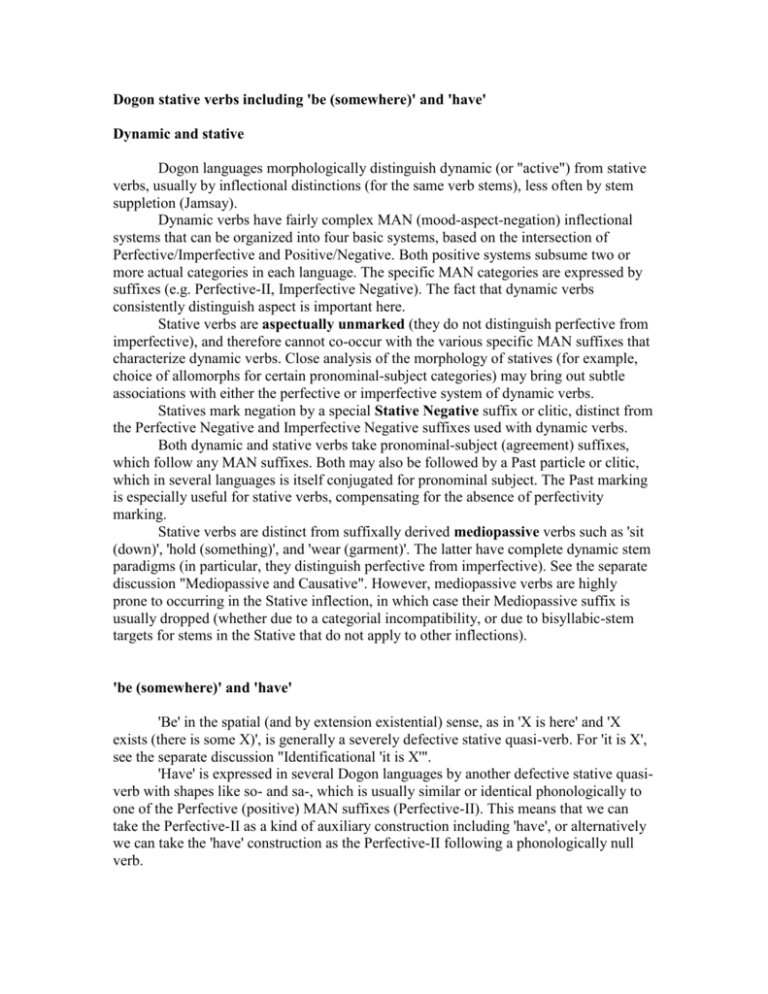
Dogon stative verbs including 'be (somewhere)' and 'have'
Dynamic and stative
Dogon languages morphologically distinguish dynamic (or "active") from stative
verbs, usually by inflectional distinctions (for the same verb stems), less often by stem
suppletion (Jamsay).
Dynamic verbs have fairly complex MAN (mood-aspect-negation) inflectional
systems that can be organized into four basic systems, based on the intersection of
Perfective/Imperfective and Positive/Negative. Both positive systems subsume two or
more actual categories in each language. The specific MAN categories are expressed by
suffixes (e.g. Perfective-II, Imperfective Negative). The fact that dynamic verbs
consistently distinguish aspect is important here.
Stative verbs are aspectually unmarked (they do not distinguish perfective from
imperfective), and therefore cannot co-occur with the various specific MAN suffixes that
characterize dynamic verbs. Close analysis of the morphology of statives (for example,
choice of allomorphs for certain pronominal-subject categories) may bring out subtle
associations with either the perfective or imperfective system of dynamic verbs.
Statives mark negation by a special Stative Negative suffix or clitic, distinct from
the Perfective Negative and Imperfective Negative suffixes used with dynamic verbs.
Both dynamic and stative verbs take pronominal-subject (agreement) suffixes,
which follow any MAN suffixes. Both may also be followed by a Past particle or clitic,
which in several languages is itself conjugated for pronominal subject. The Past marking
is especially useful for stative verbs, compensating for the absence of perfectivity
marking.
Stative verbs are distinct from suffixally derived mediopassive verbs such as 'sit
(down)', 'hold (something)', and 'wear (garment)'. The latter have complete dynamic stem
paradigms (in particular, they distinguish perfective from imperfective). See the separate
discussion "Mediopassive and Causative". However, mediopassive verbs are highly
prone to occurring in the Stative inflection, in which case their Mediopassive suffix is
usually dropped (whether due to a categorial incompatibility, or due to bisyllabic-stem
targets for stems in the Stative that do not apply to other inflections).
'be (somewhere)' and 'have'
'Be' in the spatial (and by extension existential) sense, as in 'X is here' and 'X
exists (there is some X)', is generally a severely defective stative quasi-verb. For 'it is X',
see the separate discussion "Identificational 'it is X'".
'Have' is expressed in several Dogon languages by another defective stative quasiverb with shapes like so- and sa-, which is usually similar or identical phonologically to
one of the Perfective (positive) MAN suffixes (Perfective-II). This means that we can
take the Perfective-II as a kind of auxiliary construction including 'have', or alternatively
we can take the 'have' construction as the Perfective-II following a phonologically null
verb.
language
'be'
Najamba
Beni
Nanga
Tabi-Sarinyere
Jamsay: Hum
"
Nonh
'not be'
-
'have'
-
s
-
-
'not have'
-
-
-
-
-
-
-
We see *bu/bo- for 'be' in three languages, but a distinct form in Tabi-Sarinyere.
A slightly distinct set of three languages have suppletive 'not be' forms based on or
- (N = velar nasal). The two Jamsay 'be' forms are directly related to
3rd person Human and Nonhuman pronominals; the corresponding 'not be' forms contain
a Stative Negative allomorph - and are relatively transparent. The 'have' stems point
to a prototype of the general type *So/a-, which is negated by an allomorph of the Stative
Negative suffix.
'know' and 'want'
Verbs with these senses occur in some languages only in stative forms, and may
have irregular negative counterparts that resemble other Stative Negative forms. The
morphologically Stative forms used in these senses are shown in the table below (blanks
indicate that the relevant verb is not Stative).
language
'know'
'not know'
Walo
Nanga
Beni
Najamba
Tabi-Sarinyere
Jamsay
----
----
-
-
--
'not want'
-
--
'want'
-
-
--
-
ina-
-
-
--
The sections below summarize, language by language, the structure of more or
less productive Stative inflections for regular verbs (e.g. stance verbs).
Nanga
Verbs of stance, holding/carrying, and others such as 'be(come) closed' and 'fear',
have full dynamic paradigms, and also a productive stative paradigm characterized by
initial Cv- reduplication, and a mutation of the stem-final vowel to /a/ or /o/, with no
further suffix other than the pronominal-subject ending. Many of the verbs that can occur
in the Stative are elsewhere mediopassive in form, but these verbs drop Mediopassive
suffix -yE- in the Stative.
The corresponding Stative Negative omits the reduplication, keeps the mutated
final /a/ or /o/, and adds the conjugated Stative Negative clitic.
Beni
A fairly productive stative paradigm is attested with verbs denoting stance or
other positions ('sit', 'be right-side up', 'be tilted', 'be hanging', etc.). There is an initial Ltoned Ci- reduplication, followed by the stem with {HL} tone; both of these features are
shared with the (dynamic) reduplicated Perfective (whereas the reduplicated Imperfective
ends in a high tone). The reduplicated Stative differs from the reduplicated Perfective in
requiring a bisyllabic stem, in mutating stem-final /i/ to /a/ (except in monosyllabics), and
in using distinct 3rd person subject suffix allomorphs.
Najamba
Verbs of stance, holding, being put, and being attached may occur in a productive
Stative paradigm. Many of the verbs of stance and of holding elsewhere require a
Mediopassive suffix that is omitted in the Stative (except with monosyllabic roots). The
Stative paradigm is characterized by a final /a/ or /o/ on the stem, i.e. the A/O stem,
which in this language also occurs before most nonzero MAN suffixes.
Tabi-Sarinyere
A productive stative construction is formed by optional initial Cv- reduplication
of the verb, which otherwise takes its usual "combining form" (with final high vowel).
- 'be' or, for
- with a puzzling element that may be historically related to
the verb 'put down'.
A progressive construction consisting of a verb plus - is also treated
morphologically as stative. Its negation is -
Jamsay
There is no productive Stative inflection. However, a few verbs (intransitive and
transitive) do have Stative counterparts (always intransitive). The Stative stem is either
irregular phonologically or completely suppletive. The Stative forms are all-low toned
and behave like unsuffixed Perfectives (which occur, for dynamic verbs, in sentences
with a preceding, often focalized, constituent). kun- 'be (put) inside' is the only
consonant-final verb in the Jamsay lexicon.
dynamic
gloss
Stative
gloss
a.
kuno- (H)
naana- (H)
'put X (somewhere)'
'put X up (on sth)'
kun- (L)
naa- (L)
'X be (put) inside'
'X be up on (sth)'
b.
diNe- (LH) 'X sit (down)'
daaⁿ- (L)
'X be in sitting position'
[cf. also deene- (LH) 'put X down', frozen causative of 'sit']
ine- (LH)
'X lie down'
umo- (L)
'X be lying down'
These statives take Stative Negative suffix (or clitic) -lv or -rv, cf. -rv in negative
forms of 'be' and 'have'.
